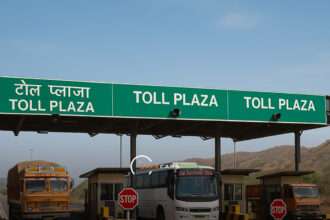A recent dashcam footage shared online vividly illustrates the dangers of blind spots on roads, emphasizing the potential hazards that arise when vehicles, especially scooters or motorcycles, enter these blind zones. The video captured a Tata Safari Storme SUV in Hyderabad involved in a slow-speed collision, shedding light on the crucial importance of vigilance and awareness on the road.
**The Accident Scenario**
The video, sourced from a viewer and shared by Prateek Singh on YouTube, unfolds in Hyderabad, depicting a routine two-way road with the Safari Storme navigating through potholes at a speed ranging between 10-20 kmph. As the SUV proceeded, a woman appeared on the left side of the road, while the car remained in its designated lane. Suddenly, a scooter rider emerged unexpectedly between the two vehicles, colliding with the left front of the Safari Storme while attempting to turn in.
The impact caused the scooter rider to lose balance and fall onto the road. Despite not wearing a helmet, the rider swiftly got up and departed from the scene. Remarkably, due to the Safari Storme’s slow speed, the severity of the accident was mitigated, preventing the rider from being crushed by the vehicle’s wheel.
**Avoiding Blind Spot Incidents**
Blind spots pose significant risks on the road, creating zones where vehicles might not be immediately visible to drivers. To prevent accidents stemming from blind spot encounters, several measures can be adopted:
1. **Regular Checking and Adjusting Mirrors**: Drivers should routinely check and adjust side and rear-view mirrors to minimize blind spots and maximize visibility.
2. **Use of Turn Signals**: Before changing lanes or making turns, signaling intentions well in advance allows other vehicles, including motorcycles or scooters, to anticipate movements.
3. **Maintain Safe Distances**: Keeping a safe distance from adjacent vehicles provides ample reaction time to avoid collisions if sudden maneuvers occur.
4. **Increase Awareness**: Motorists must remain attentive, constantly scanning surroundings and checking blind spots by physically turning their heads before making lane changes or turns.
5. **Wear Safety Gear**: Riders must prioritize safety by wearing helmets and appropriate protective gear, reducing the risk of severe injuries in case of accidents.
**The Road to Safer Driving**
The incident underscores the importance of remaining vigilant on the road, particularly in scenarios involving blind spots. Both drivers and riders bear the responsibility of ensuring their visibility to others while anticipating potential hazards.
By embracing proactive measures such as regular mirror checks, signaling intentions, maintaining safe distances, enhancing awareness, and prioritizing safety gear, motorists contribute significantly to preventing blind spot accidents and fostering safer roads for all.
**Conclusion**
Blind spot incidents serve as stark reminders of the critical need for heightened vigilance and caution while navigating roadways. Through a collective commitment to proactive safety measures, drivers and riders can mitigate risks, prevent accidents, and pave the way for safer, more secure journeys for everyone on the road.




